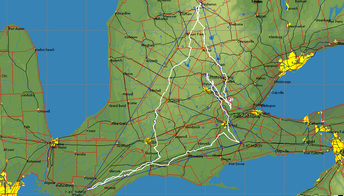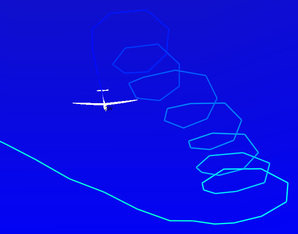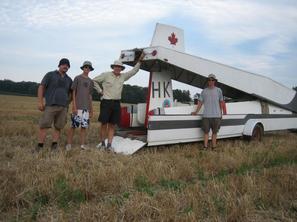Cross Country Soaring
Once licensed, you can now work on more advanced soaring skills. This is where the challenge begins for the new glider pilot. At SOSA our instructors, many of whom are extremely accomplished cross-country pilots themselves, are ready to teach these valuable skills.
|
The words gliding and soaring are often used as synonyms. The subtle difference between the two is that gliding implies that after the glider is towed aloft it gently glides to the ground under the pull of gravity. Soaring on the other hand involves the glider pilots defying gravity by using their knowledge and skill to find invisible rising air currents (thermals) and using these to not only arrest the descent due to gravity, but to also ascend with the thermal. With the height gained, glider pilots can now translate this height gain into distance across the ground. In the image to the right, the white line on the map shows the actual track covered by a glider during a 620 km task in south-western Ontario. (click on the image to enlarge it and view the route flown)
All gliders, based on their design, have a maximum glide ratio or best lift to drag (L/D) ratio. For example, an L/D ratio of 40:1 means that for every 40 km of forward travel over the ground the glider will lose 1 km of height. In comparison, most powered aircraft/passenger jets have an L/D ratio of about 10:1 (without engine assistance). Cross-country soaring is flying the glider out of glide range from the home airport. This facet of the sport is where the real challenge begins. During your basic training your instructors will teach you how to find thermals and how to circle in them to ascend with the air. They will also teach you the basics of gliding from the top of this thermal to find the next thermal. To provide specific goals for new pilots to achieve in their soaring progress the Soaring Association of Canada (SAC) has the ABC and Bronze badge system and this is followed by the FAI's - IGC (Federation Aeronautique Internationale - International Gliding Commission) Silver, Gold and Diamond Badges and Diplomas. A Badge
Cross-country soaring is an exciting and challenging activity. It requires the pilot to put together many concepts such as the basic piloting of the glider, navigation, knowledge of the weather, the ability to predict the location of and find thermals, the ability to maximize the climb rate in thermals, knowledge of the terrain and crops, and knowledge of the performance characteristics of the glider. The cross-country pilot must constantly assess many of these items simultaneously.
As mentioned above, your instructor will introduce you to finding thermals and how to climb in them during your basic training, but the primary goal of your basic training is to teach you the skills and judgment required to pilot a glider under various conditions. Upon mastering this set of skills and judgment you earn your glider pilot license. This is where the challenge begins for the new glider pilot and at SOSA the instructors are ready to challenge you and teach these cross-country skills. Once licensed, you can now work on more advanced cross-country training. The starting point in your cross-country flying is to earn your Bronze Badge. At SOSA the Bronze Badge is a prerequisite to cross-country flying. During a weekend long course you will perfect your spot landings and demonstrate three consecutive spot landings to an instructor. You will also demonstrate navigation and glide calculation abilities by flying to a neighbouring airport and landing there. This will likely be your first landing at somewhere other than SOSA and will challenge you to plan your circuit properly without all the local clues that you subconsciously used at home. There are many cross-country skills to learn and at SOSA this training is typically conducted one-on-one with your instructor of choice. They will teach you how to "read" a cloud to determine which cloud and more specifically, which spot under the cloud is most likely to have a thermal. They will teach you how to fly from one point to another while maximizing your time in rising air and avoiding sinking air. Navigation, while not the skill it once was because of GPS, is still an important skill. To fly cross-country you must fly to a specific point over the ground and without the ability to map read and use the GPS arrival at your destination can be a problem. Terrain and crops are items with which the glider pilot must be familiar. The type of terrain can determine where you will find the best thermals. Different types of crops can also affect the thermal strength and your landing options. At some point in your cross-country flying, you will inevitably find yourself in a position where you cannot find a thermal and you are not within glide range of an airport. Your instructor will also teach you how to manage the situation. You need to select a field into which you will land. You will be taught how to determine the wind direction, type of crop in the field, whether or not the field is smooth, if it has a slope and whether or not there are obstacles, such as power lines to avoid. You will think back to your flight to the neighbour's airport and the lessons you learned about planning your circuit and making a spot landing and you will make a safe landing in the field and then call home for a retrieve crew to bring the trailer. Your first off-field landing - what a rush! Once you have learned the basics of cross-country and completed your Silver Badge requirements you are on your way as a cross-country pilot. You can now work towards the higher level badges, and can think about flying in a contest. Contests, quite simply are races. Each day a specific cross-country task is assigned with a specified route and distance according to the weather. Each pilot is launched sequentially and 15 minutes after the last pilot is airborne, the race starts. It is now up to each pilot to decide when to start and how best to maximize their speed over the assigned task. The gliders' positions are recorded by GPS and at the end of the day the pilot who completed the course at the fastest speed wins the day. Contests are multi-day events with the National Contest lasting ten days. SOSA also holds an annual fun contest, the Mudbowl, as an entry level contest to teach new pilots about contest flying. SOSA pilots fly cross-country flights on pretty much any day the weather conditions allow. Some pilots fly for fun, some for the challenge, and some as practice for contests. Most of these flights are posted to the On-line Contest, a web-based forum that scores all flights submitted worldwide on a daily basis. |








